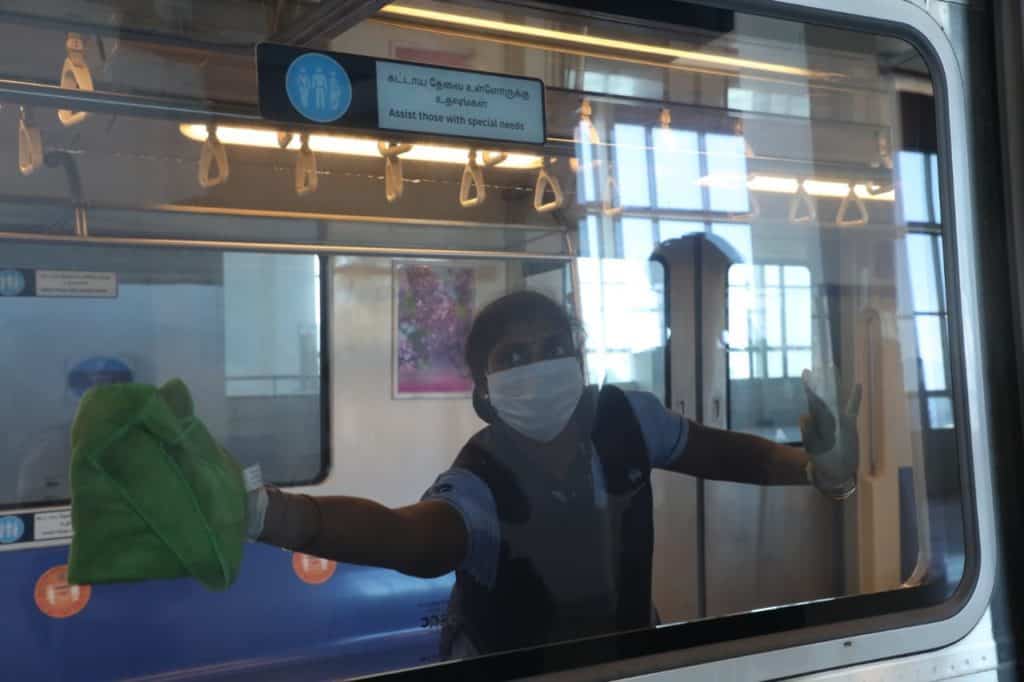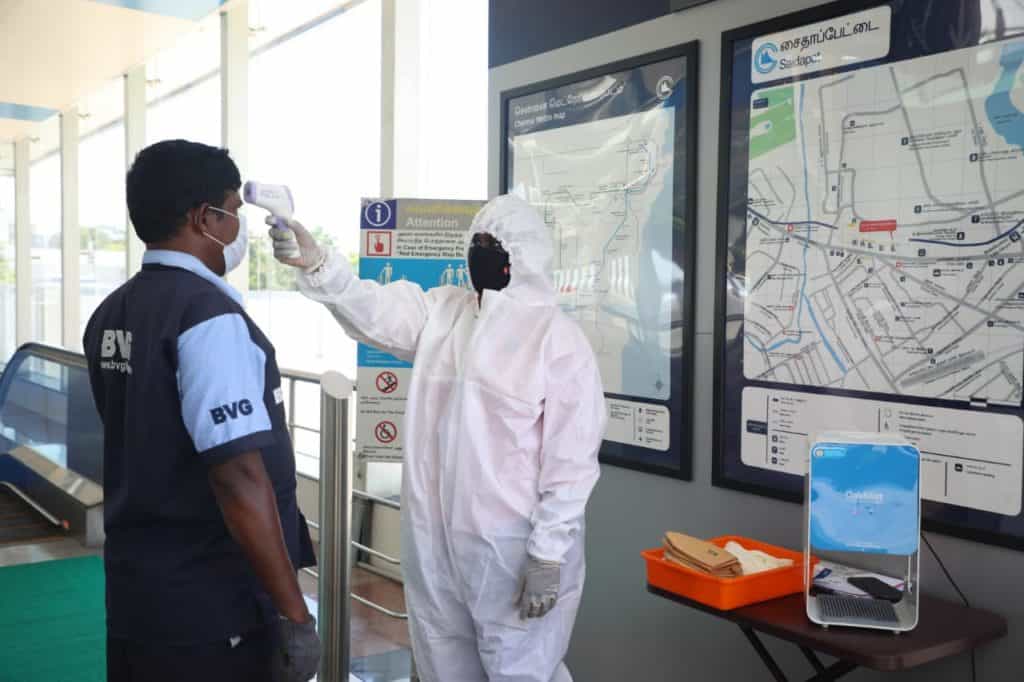After a gap of over five months, Chennai Metro trains is back on track. The Chennai Metro Rail Limited (CMRL) has decided to resume rail services in different phases. In the first phase, the Blue Line, between Airport Metro Station and Washermenpet Metro Station, resumed on September 7th. In the second phase, the Green line, plying between St Thomas Mount and Puratchi Thalaivar Dr M G Ramachandran Central Metro), will be operational from September 9th.
Train services will run at 5-minute frequency during peak hours and 10-minute frequency during non-peak hours.

The inter-corridor movement between Puratchi Thalaivar Dr M G Ramachandran Central Metro Station and Airport Metro Station will remain suspended as the reopening is done in a graded manner. Travellers can deboard at Arignar Anna Alandur Metro for interchange towards Airport Metro station.
Commuters, who use multiple public transportations to get to their workplace, are relieved.
Tamizhan, a resident of Tambaram, heaved a sigh of relief as the Metro operations resumed. He takes his two-wheeler to reach Guindy and then takes the Metro to reach his workplace in Washermanpet. “My home is 35 kms from my office and I had to ride my two-wheeler all the way when my boss asked me to report to work after Unlock 2.0 guidelines were released,” he added.
Dr Vinodh Rajkumar, a regular Metro commuter and an orthopaedic surgeon at Stanley Medical College and Hospital, states that he will use Metro trains once the number of COVID cases come down in Chennai. “Of course, I will wear an N95 mask, a face shield, gloves and stand 6 feet apart from others,” he says.
On Day 1 of operations, 5,033 passengers used the Chennai Metro. Among them, 4,869 passengers used smartcards and 164 used the QR code facility for purchasing the tickets. It is to be noted that around one lakh passengers used the facility every day before the lockdown was imposed.
The chief concern among commuters at this stage, of course, is safety and many continue to have fears over the risk of a spike once mass transit begins on the Metro.

New riding norms
Regular Metro commuters are urged to adhere to the new riding protocol. Here are the various rules and regulations imposed by the CMRL in all stations in Chennai to mitigate the risk of spread of the virus.
- Two entrances of the Metro stations will be opened initially. Based on demand, the opening of other entrances to these stations shall be explored.

- To minimise crowding and rush during boarding and deboarding, the stoppage time at stations has been increased from 20 seconds to 50 seconds to facilitate maintenance of physical distance. The dwelling time (the time a train stands at the platform for allowing passengers to board or alight) will be reviewed and revised depending upon footfall at the stations.
- Social distancing sticker markings are pasted in places where passengers move/wait within the premises.
- Passengers handling staff working at CMRL stations are provided face masks, shields, gloves and PPE coveralls.
- Passengers are advised to stand on alternate steps in the escalators to maintain social distancing. Lifts shall be shared only with 2 to 3 persons at a time and usage of lifts shall be encouraged for aged and persons with disabilities only.
- Baggage is scanned in Baggage Scanner and passengers should pass through DFMD (Door Frame Metal Detectors) for contactless screening.

Air conditioning system
- The CMRL’s underground stations are air-conditioned and measures have been taken to maintain the inside temperature at 24 degrees – 30 degrees Celsius and relative humidity at 40 – 70%.
- The temperature inside the coaches is maintained at 25-27 degrees Celsius as per guidelines from the Ministry of Housing and Urban Affairs (MoHUA) and fresh air supply will be increased from 25% to 100%.
- Air circulation paths are provided with UV (Ultra Violet) ray emitters which emit ultraviolet rays that kill microorganisms present in the circulating air. Metro rail tunnels are also being ventilated using ventilation fans to mute the microorganisms.
- Indoor air quality is maintained by introducing fresh air inside the station at around four times more than the recommended rate and the fans are run continuously at maximum capacity as per Central Public Works Department (CPWD) and the Indian Society for Refrigeration and Air – Conditioning (ISHRAE).
- One of the new measures implemented in the post-COVID scenario is the deployment of two-level air filters in air handling units. The primary filter traps particles of size 10 micron and above and secondary filter traps 5 microns and above.
- Air handling units and fresh air fans would be operational two hours before the service is started and will continue for two hours beyond the last train services, to ensure that there is no residual contamination inside.
- Air filters, cooling coils, air diffusers and grills are cleaned once in a week with 1% Sodium Hypochlorite solution.
Ticketing Facility

- Usage of smart cards shall be encouraged and recharge of Smart Cards may be done through web-top up or cashless methods.
- Travel Card Reader machines are installed at all 32 metro stations to avoid queuing at the Ticket Vending Machines (TVM). These machines can help check the validity of smart cards and recharge them.
- Single journey tokens are discouraged; however, it will be issued on need basis and those tokens will be sanitised.
- Passengers can revalidate their expired parking passes before October 7th using the travel card reader. Cashless transaction facility has been enabled at all parking lot machines at metro stations.
How to use QR Code ticketing facility
- Passengers can book tickets and buy passes of their choice (single journey ticket, round journey ticket and trip passes) in the form of QR codes in the existing CMRL mobile app.
- The QR code will be scanned by QR scanners fitted to a particular gate at every station for entry and exit, making the entire journey completely contactless.
- Features like rescheduling and cancellation of tickets have also been included in the app for the convenience of the passengers. The digital payment options include debit card, credit card, UPI and net banking facilities.
Notes from New York
New York public health experts have warned about the transmission risks involved while travelling in public transportation. As the subway cars are crowded and poorly-ventilated, commuters are at high risk. Here are some of the measures taken by the New York government to protect its commuters:
– The subway will be shut between 1 am and 5 am for an intense cleaning and disinfection regimen with new ultraviolet technology.
– During the peak hours, the Metro-North will increase service to 60% of the usual weekday schedule.
– The Metropolitan Transportation Authority (MTA) has deployed workers across the subway rails to report and alert overcrowding in real-time.
– The transport department has also requested for addition of 60 miles of bus lanes to the existing 144 miles that could encourage subway users to the viable alternative.